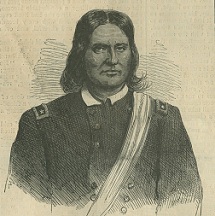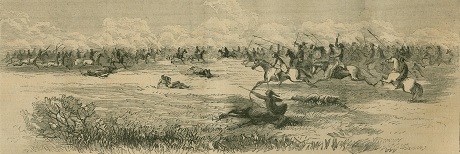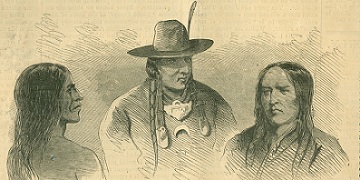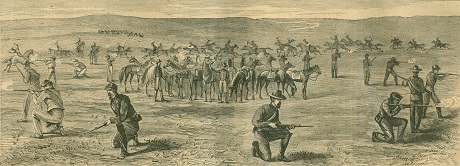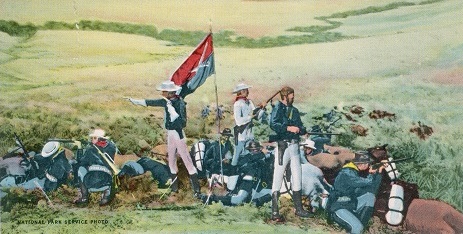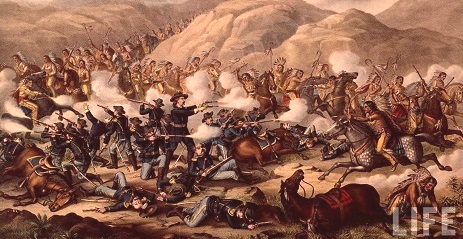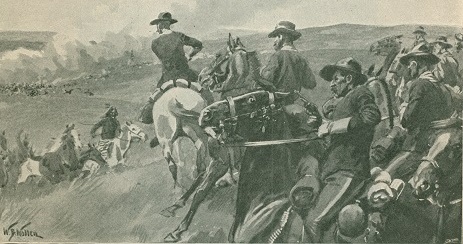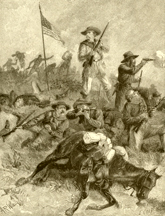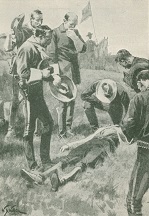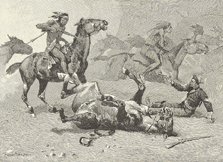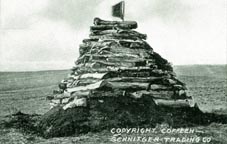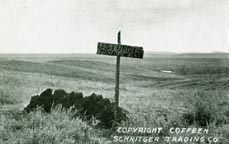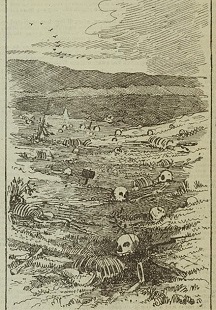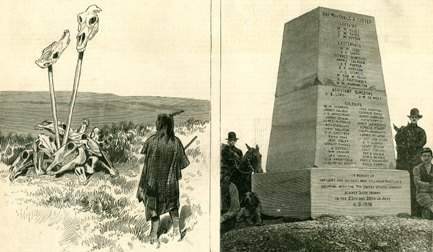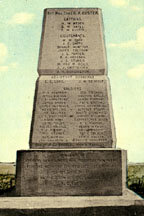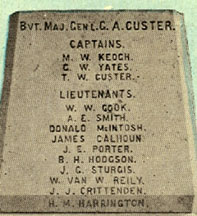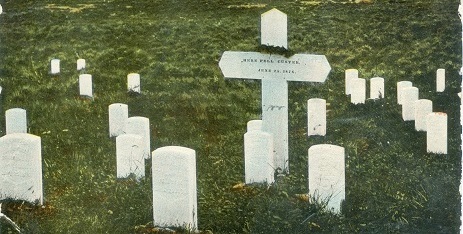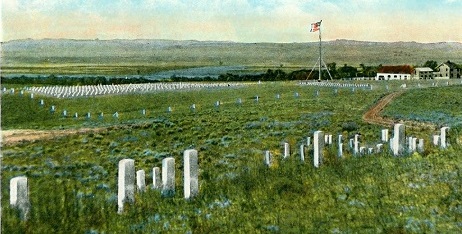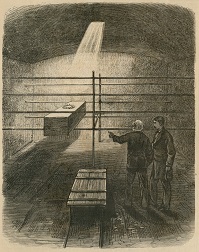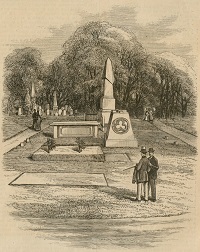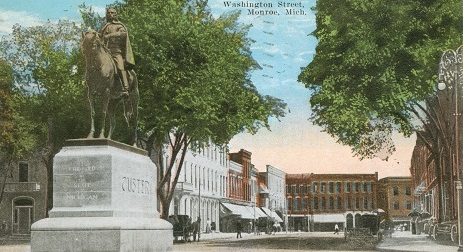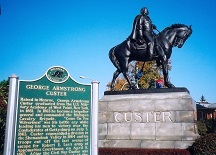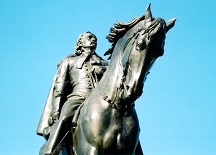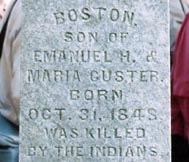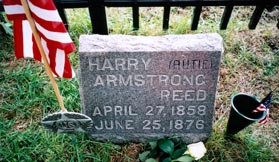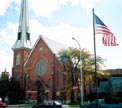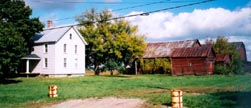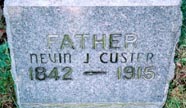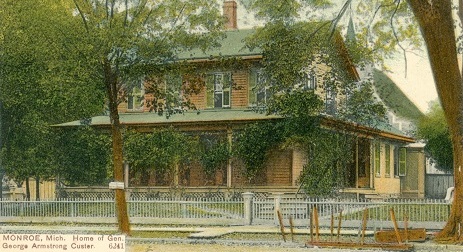
|
General Custer Family Album |
| The Story of General George Armstrong Custer and His Brother Capt. Thomas Ward Custer - Rebecca Minerd and Their Son Thomas C. Custer - Our "Custer Connection" Reunion - "Speckled Legacy: Tom Custer in American Pop Culture" |
| ~ Origins in New Rumley, Ohio ~ |
|
Emanuel H. and Maria (Ward) Custer, parents of General George Armstrong Custer and Thomas Ward Custer, who were longtime neighbors of Samuel and Susanna (Hueston) Minerd in both Harrison and Wood Counties, OH. Courtesy of the Little Bighorn Battlefield National Monument/National Park Service.. |
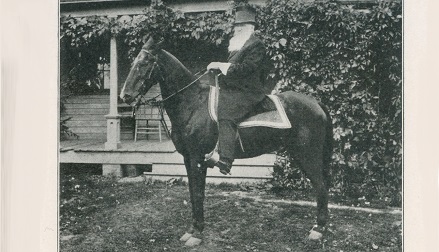 |
Emanuel Custer on the horse "Dandy," a favorite of the General's. The Story of the Dining Fork, Minerd.com Archives. |
|
|
Sketch of the Custer house and Brethren Church in New Rumley, 1886, by Henry Howe.Courtesy Minerd.com Archives. |
|
Graves of two infant brothers of General George and Thomas Ward Custer, at the English Lutheran Cemetery in New Rumley, Harrison County, OH. In this small rural cemetery also rest many of our cousins, including pioneers John and Maria (Kohl) Minard and their children, grandchildren and great-grandchildren. Minerd.com Archives. |
|
|
Birthplace and early home of General George and Thomas Custer in New Rumley. Henderson's Art Gallery of Scio, OH published this postcard circa 1907. Minerd.com Archives |
|
|
Above: Custer State Memorial at New Rumley, Harrison County, OH, on the actual site of the birthplace of the Custer brothers. Minerd.com Archives |
|
|
Statue of the General in New Rumley, OH, dedicated in 1932. Minerd.com Archives |
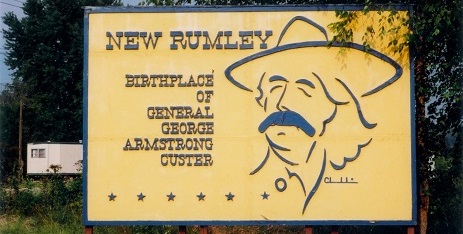 |
Large sign in Jewett celebrating Custer's birthplace, 2001.Minerd.com Archives. |
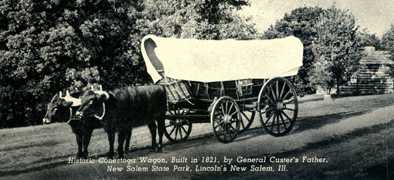 |
"Historic Conestoga wagon," said to have been built by Emanuel Custer in 1821, and used by the family for its moves across Ohio and then back and forth into Michigan. Preserved today at New Salem State Park, IL. Minerd.com Archives |
|
| ~ Civil War-Era Home in Tontogany, Wood County, Ohio ~ |
|
Front view of the farmhouse where the General's parents and Tom resided near Tontogany during the Civil War years, depicting members of the Williams family, owners at the time the image was made later in the 1800s. Minerd.com Archives |
~ Tom Custer's Civil War Battles ~ |
|
Battle of Chickamauga -- Sept. 19-20, 1863.Minerd.com Archives |
|
Battle of Missionary Ridge, Tennessee -- Nov. 25, 1863.Minerd.com Archives |
|
Battle of Kennesaw Mountain, Georgia -- June 27, 1864.Minerd.com Archives |
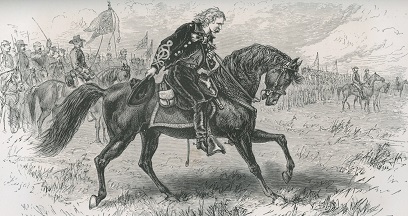 |
General Custer saluting Confederate General Ramseur following the Woodstock Races battle on Oct. 9, 1864. From Whittaker's A Life of Major Gen'l George A. Custer, drawn by Alfred Rudolph Waud. Minerd.com Archives |
|
Gen. Custer's Cavalry Division display Confederate colors captured by Tom and others at the Battle of Sailor's Creek, April 6, 1865. From Sabre and Bayonet, compiled by Theo. F. Rodenbough (New York: G.W. Dillingham Co., 1897). Minerd.com Archives |
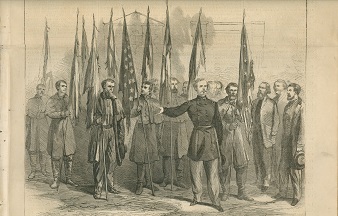 |
General Custer presenting captured Confederate flags at the War Department in Washington, DC. Sketched by A.R. Waud. Harper's Weekly, Nov. 12, 1864. Minerd.com Archives |
 |
General Custer receiving the first flag of truce -- "a towel on a pole" -- sent by General Lee after the Battle of Appomattox. From Whittaker's A Life of Major Gen'l George A. Custer, drawn by A.R. Waud. Minerd.com Archives |
| ~ Indian War Years on the Great Plains ~ |
|
|
After General Custer and his 7th Cavalry failed to catch Cheyenne warriors near Pawnee Fork, Kansas, his superior officer Maj. Gen. Winfield Scott Hancock ordered the hostiles' village to be burned, north of Fort Dodge, April 19, 1867. From Harper's Weekly, June 8, 1867, and sketched by Theodore R. Davis. Minerd.com Archives |
|
Left, Chief Satanti of the Kiowa tribe, and right, Little Raven, of the Arapahoes, whose warriors attacked postal stations, stagecoach facilities, wagon trains and railroad laborers in Kansas in May 1867, while Custer and the 7th Cavalry cooled their heels at Fort Hays, Kansas, waiting for the exhausted horses to regain strength. Satanti's earnest desire for peace earned him an army uniform. Sketch by Theodore R. Davis, from Harper's Weekly, June 8, 1867. Minerd.com Archives |
|
Cavalrymen drilling at Fort Wallace in the summer of 1867. From a photograph by Maj. A.R. Calhoun and Dr. Bell, surveyors for the Union Pacific Railroad, as published in Harper's Weekly, July 27, 1867. Minerd.com Archives |
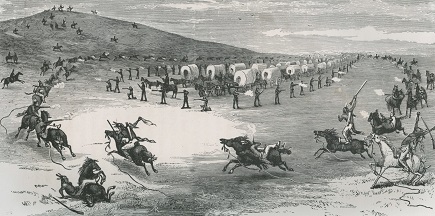 |
A three-hour attack on a re-supplied wagon train returning from Fort Wallace in June 1867. From Whittaker's A Life of Major Gen'l George A. Custer.Minerd.com Archives |
|
Troopers with Company G of the 7th Cavalry under attack by Cheyenne warriors in what Harper's Weekly called a "desperate battle" on the Smoky Hill route through Kansas near Fort Wallace. Led by Chief Roman Nose on June 26, 1867, the Indians "ran off the Overland Stage Company's stock [and] then advanced toward the fort." From a photograph by Calhoun and Bell, Union Pacific Railroad surveyors, as published July 27, 1867. Minerd.com Archives |
|
Remains of Sgt. Frederick Williams, killed in the June 26, 1867 battle near Fort Wallace, Kansas. "The body was fearfully mutilated," reported Harper's Weekly (July 27, 1867). "His scalp was taken, two balls pierced his brain, and his right brow was cut open with a hatchet. His nose was severed and his throat gashed. The body was opened and the heart laid bare. The legs were cut to the bone, and the arms hacked with knives. We give an engraving of the body from a photograph." Minerd.com Archives |
|
Pawnee Killer and his Oglala braves, who fought against General Custer's 7th Cavalry along the Republican River, halfway between Colorado's Fort Sedgwick and Fort Wallace in northwest Kansas, in June 1867. From Harper's Weekly, Aug. 17, 1867, sketched by T. R. Davis. Minerd.com Archives |
|
Led by Pawnee Killer, hostile Sioux warriors attack on June 24, 1867, which the 7th Cavalry held off after an hour of the Indians' circling movements and shooting. Sketch by T.R. Davis, Harper's Weekly, Aug. 17, 1867. Minerd.com Archives |
|
Warriors of the Sioux and Cheyenne tribes attack a wagon train, the type of hostility Gen. Custer and the 7th Cavalry were trying to prevent. Sketch by T.R. Davis, Harper's Weekly, Aug. 17, 1867. Minerd.com Archives |
 |
Custer's men fording the Platte River at North Platte, Nebraska, as sketched by T. R. Davis and published in Harper's Weekly, Aug. 3, 1867. Minerd.com Archives |
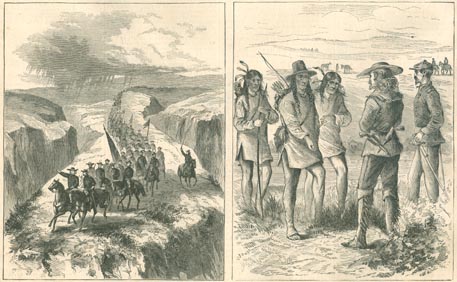 |
Traveling in a prairie canyon, left, and the General's interview with Pawnee Killer of the Oglala tribe, where the hostile Indian asked for coffee and sugar after attacking the army earlier in the day. Printed in Harper's Weekly, Aug. 3, 1867. Minerd.com Archives |
 |
Sioux attempting to stampede the Seventh Cavalry's horses, in a sketch by T.R. Davis and as published in Harper's Weekly, Aug. 3, 1867. Note the sharpshooters on the plateau at right, on their stomachs, defending against the raid. Minerd.com Archives |
 |
Gen. Custer examines the arrow-ridden remains of Lieut. Lyman Kidder and 10 men of the 7th Cavalry, who had left Fort Sedgwick in Colorado to deliver a telegram from Maj. Gen. William Tecumseh Sherman, ordering Custer to change his search for hostile Indians and move closer to Fort Wallace in Kansas. Sketched by T.R. Davis and published in Harper's Weekly, Aug. 17, 1867. Minerd.com Archives |
| ~ Battle of the Washita, Oklahoma ~ |
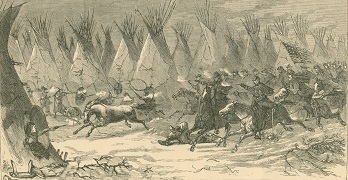 |
The Battle of Washita, otherwise known as the "Capture of Black Kettle's Camp" near what today is Cheyenne, OK. From the book Indian History for Young Folks by Frances S. Drake (New York, 1885). Tom was slightly wounded in this engagement. Minerd.com Archives |
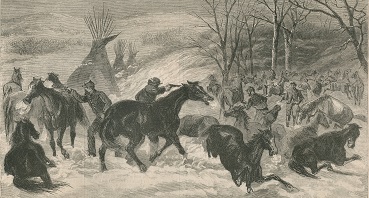 |
Custer's men shooting down "worthless" horses after the Washita battle, as drawn by Theodore R. Davis. Harper's Weekly, Jan. 16, 1869. Minerd.com Archives |
 |
"Custer's Attack." American Tobacco Co. New York Public Library |
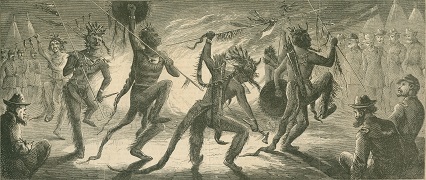 |
After the Washita victory against Black Kettle, Custer's scouts of the Osage and Kaw nations celebrated at night around a large fire, "encircled by officers and men who formed a ring comprising hundreds in number -- the front rows sitting down or kneeling," reported Harper's Weekly, Jan. 16, 1869. "The ceremonies were enlivened by music from the military bands. Inside the circle, by the Indian drummers, sat Generals Sheridan, Custer, Forsyth, and staff-officers. The Indians were highly painted, and adorned with shields, spears, war-bonnets, bows, whistles, and other 'toggery'." Sketch by Theodore R. Davis. Minerd.com Archives |
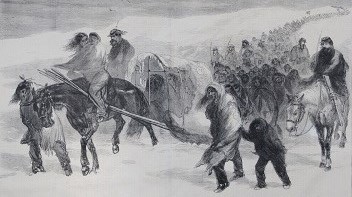 |
Southern Cheyenne prisoners captured at the Battle of Washita as sketched by Theodore R. Davis. Harper's Weekly, Dec. 26, 1868. Minerd.com Archives |
Washita Battlefield National Historic Site, Cheyenne, OK, July 2015. Minerd.com Archives |
Washita Battlefield National Historic Site, Cheyenne, OK, July 2015. Minerd.com Archives |
Despite Tom's wound in action at Washita, however slight, he is not named or pictured in the National Historic Site museum display or local plaques.Minerd.com Archives |
| ~ In the Dakotas and Montana, 1870s ~ |
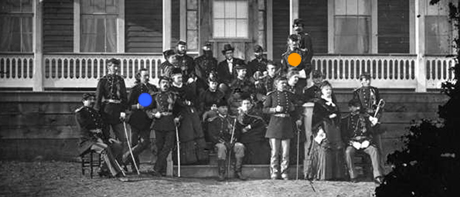 |
The General (blue dot) and Tom (orange dot) at Custer's quarters at Fort Abraham Lincoln, North Dakota in November 1873, with Seventh Cavalry officers and family, including the General's wife Elizabeth, and their brother in law Capt. James C. Calhoun and his wife Margaret (Custer) Calhoun. Denver Public Library and the Library of Congress American Memory Project |
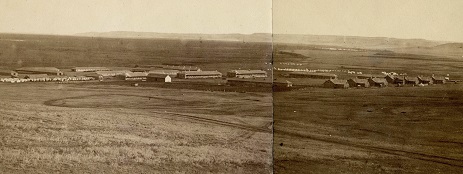 |
| Fort Abraham Lincoln, North Dakota. National Park Service |
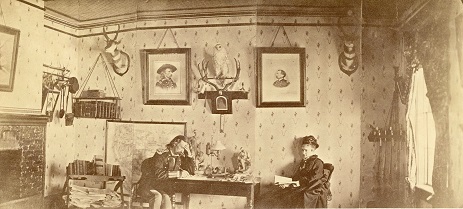 |
General and Mrs. Custer in the study of their home at Fort Abraham Lincoln. National Park Service |
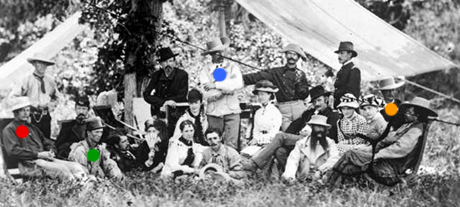 |
Tom (orange dot) and his brothers the General (blue dot) and Boston (green) and brother in law James Calhoun (red) in July 1875 at an outing near the Little Hart River at Fort Abraham Lincoln, North Dakota. Denver Public Library and the Library of Congress American Memory Project |
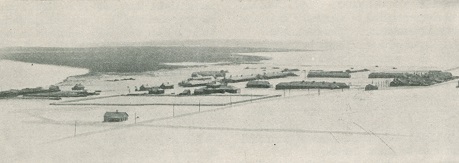 |
Another view of "Fort Abraham Lincoln North Dakota, where General Custer and his regiment were stationed before starting on their ill-fated expedition," from a photo by D.F. Barry, published in "The Massacre of General Custer and His Command," Wide World Magazine, 1901. Minerd.com Archives |
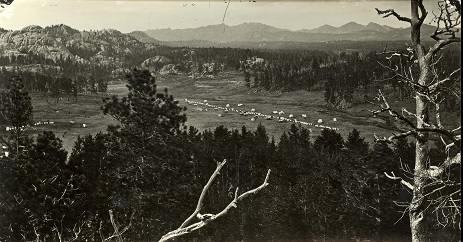 |
The Custer camp along French Creek, where the Custer expedition first discovered gold in 1874, today a South Dakota state park. National Park Service |
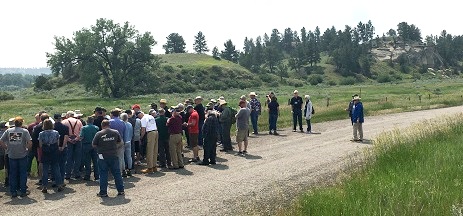 |
Site of the Pease Bottom battle, Aug. 11, 1873, where Tom commanded Co. A, seen here during a 2023 tour of the Little Big Horn Associates. The Custers were part of a military column accompanying Northern Pacific Railway surveyors working on the north side of the Yellowstone River. Minerd.com Archives |
| ~ Images of the Little Big Horn, Montana ~ |
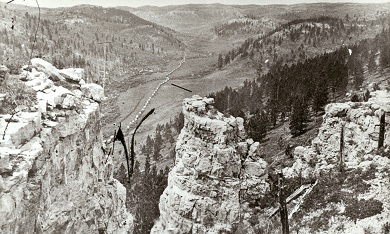 |
Custer's wagon train wending its way through Castle Creek Valley as it enters the Black Hills. Until the Custer expedition of 1874, the Black Hills was an unknown and mysterious land, sacred to the Cheyenne and Sioux. Custer entered the area from the west and for the first time, white men viewed the spectacular mountains which were holy ground to the Indians. South Dakota State Historical Society |
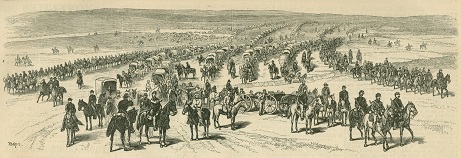 |
Gen. Custer's expedition on the march into the Black Hills, from Frank Leslie's Illustrated Newspaper, May 1, 1875.Minerd.com Archives |
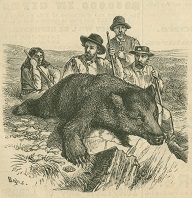 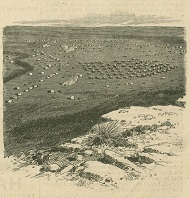 |
Left: Custer with a grizzly bear he brought down in the Black Hills, on Aug. 7, 1874, with help from his chief scout Bloody Knife, Private Noonan and Capt. William Ludlow, from a photograph by E.H. & T. Anthony & Co. Right: the Custer expedition in camp at Hidden-Wood Creek in the Black Hills. From Frank Leslie's Illustrated Newspaper, May 1, 1875.Minerd.com Archives |
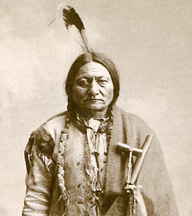
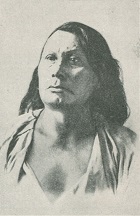 |
Above: Left: Sitting Bull, leader of the Sioux nation which attacked the Seventh Cavalry and Custer at Little Big Horn. Right: "Chief Gall, who was in supreme command of the Indian Forces," from a photo by D.F. Barry, published in "The Massacre of General Custer and His Command," Wide World Magazine, 1901.Minerd.com Archives |
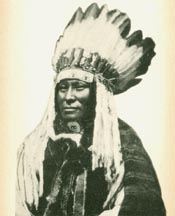 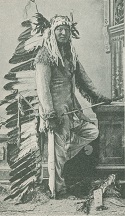 |
Rain in the Face (Etomo Gozue), a Sioux warrior who held a personal grudge against Thomas Ward Custer and was rumored to have cut out Tom's heart. Left: image taken near Fort Keough, Montana, circa 1879, originally copyright L.A. Huffman. Right: another image of Rain in the Face, from a photo by D.F. Barry, published in "The Massacre of General Custer and His Command," Wide World Magazine, 1901.Minerd.com Archives |
|
Artist's diorama depiction of the Custer brothers' last minutes at Little Big Horn, prior to the Sioux attack. National Park Service |
|
"Custer's Last Stand," 1889, by Kurz & Allison. Google Life Magazine Photo Archive |
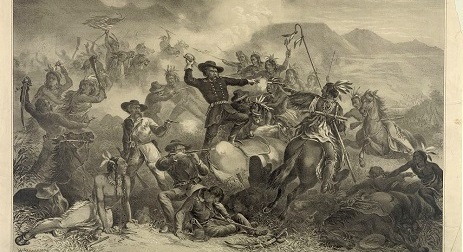 |
| "General Custer's Death Struggle" - by Henry Steinegger. Lithograph by Britton, Rey & Co., San Francisco, circa 1878. Library of Congress |
|
"The Massacre of General Custer and His Command," by H.B. Woller, published in Wide World Magazine, 1901, captioned: "We were forming into line to meet our supposed enemy."Minerd.com Archives |
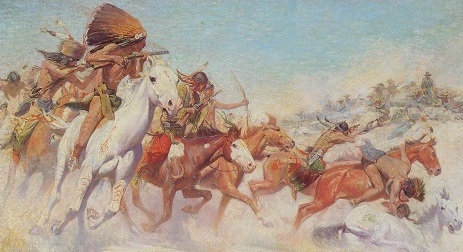 |
"William Herbert Dunton (1878-1936), "The Custer Fight," ca. 1915, oil on canvas. Gertrude Vanderbilt Whitney Trust Fund Purchase. "The Battle of the Little Bighorn in 1876 captured America's attention. In William Herbert Dunton's painting, the Sioux warriors -- rather than Custer's soldiers -- form the primary focal point. This emphasis on the Indian warriors, however, may be due less to an interest in portraying history from their point of view and more to a fascination with capturing their picturesque war bonnets and the painted ponies they rode into battle."Buffalo Bill Center for the West |
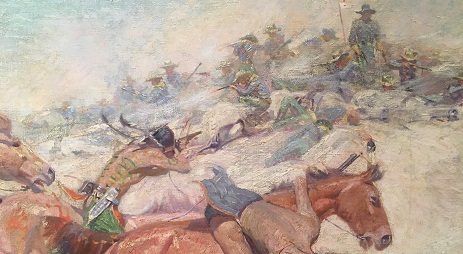 |
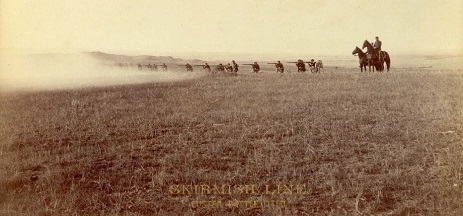 |
"Skirmish Line, Custer Battlefield." Re-enactment photo by D.F. Barry. National Park Service. |
|
Left: "Custer's Last Fight," by A.R. Waud. Right: "The Massacre of General Custer and His Command," by H.B. Woller, published in Wide World Magazine, 1901, captioned: "General Custer had been shot in the temple and in the left side."Minerd.com Archives |
 |
"Custer's Last Fight," drawn by A.R. Waud and engraved by McCracken. From Whittaker's A Life of Major Gen'l George A. Custer. Minerd.com Archives |
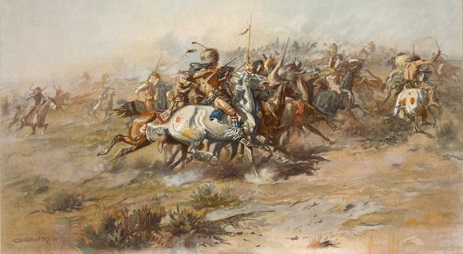 |
| "The Custer Fight" painting, circa 1903, by Charles Marion Russell (1864-1926). Library of Congress |
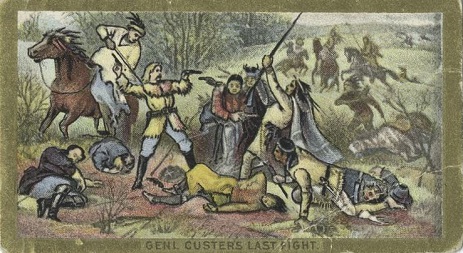 |
| "Gen'l Custer's Last Fight." American Tobacco Co. New York Public Library |
 |
| "Heroic Death of Custer." New York Public Library |
|
Above: Left - "Unhorsed" sketch published in Custer's Last Battle by Frederick Remington. Right - bleached bones of horses and men scattered at Little Big Horn one year after the slaughter.Minerd.com Archives |
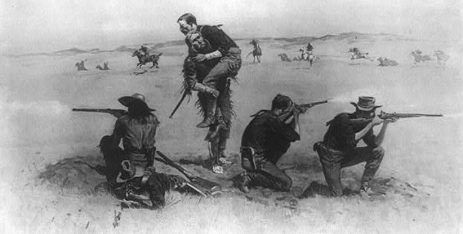 |
"The Last Stand" by Frederic Remington.Library of Congress. |
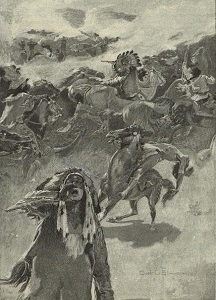 |
"We Circled All Round Him."New York Public Library. |
 |
"Custer Massacre" postcard dated 1909, by G.F. Williams.Minerd.com Archives |
|
Above left - first cairn monument on the Little Big Horn battlefield, one year later.Minerd.com Archives |
|
Left: Sketch depicting skeletal remains, captioned "The Gratitude of a Republic. Present appearance of the Custer Battle-Field." New York Public Library. Right: Closer view of the first Custer monument at the battle site, from 1877 to 1879.Minerd.com Archives |
|
Printed etching of the Little Big Horn cairn, from Frank Leslie's Illustrated Newspaper, dated Jan. 17, 1880. The print is headlined: "Montana.--Mound of bones of soldiers, Indians and horses killed during the Custer massacre, on the Little Big Horn River.--from a sketch by Holtes."Minerd.com Archives |
|
Although no one survived the Little Big Horn battle, this group posed as survivors in Frank Leslie's Illustrated Newspaper, Sept. 18, 1886, standing at the Custer monument at the battle site.Minerd.com Archives |
|
Above left: horse skulls posted on poles at Reno's Hill near the battlefield. Above right: visitors to the newly erected monument at Little Big Horn, with the names of the General and Thomas Custer, and James Calhoun, etched near the top. From Frank Leslie's Illustrated Newspaper, Sept. 18, 1886.Minerd.com Archives |
|
Memorial to the slain Seventh Cavalry members at Little Big Horn, including a close-up view showing the names of George and Tom Custer and their brother in law James Calhoun. This monument still stands today.Minerd.com Archives |
|
Large cross marks the spot where Gen. Custer fell at Little Big Horn. After a hasty burial here, his remains later were relocated to the U.S. Military Academy at West Point.Minerd.com Archives |
|
Markers in the foreground at Little Big Horn show where Custer and his men fell. The cemetery in the background is from more modern times.Minerd.com Archives |
|
Stereo view of the Little Big Horn battlefield markers, early 1900s, erroneously identifying this as the "Burial Place of Gen. Custer and His Brave Men." Some of the dead rest below the obelisk at the top of the hill.Minerd.com Archives |
~ Memorials in West Point, New York ~ |
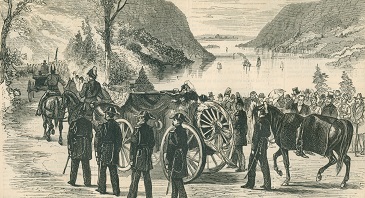 |
| Soldiers pall the general's remains to the cemetery at West Point. From a sketch by Theodore R. Davis, Harper's Weekly, Oct. 27, 1877. Minerd.com Archives. |
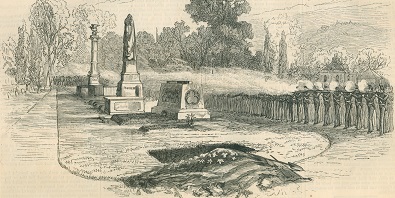 |
| Final gun salute over the grave at West Point. Minerd.com Archives. |
|
Left: the general's casket in a temporary vault in Poughkeepsie, NY before being transported to West Point. Right: visitors at the proposed place of interment at West Point. Both from Frank Leslie's Illustrated, Oct. 20, 1877.Minerd.com Archives |
~ Memorials in Monroe, Michigan ~ |
|
Famed, prominent Custer statue in Monroe, MI, as it was dedicated in 1910 in its original location.Minerd.com Archives |
|
Custer statue in Monroe, MI, relocated in the 20th century.Minerd.com Archives |
|
Grave of Emanuel and Maria at Woodland Cemetery, Monroe.Minerd.com Archives |
|
Above: Buried in the Custer plot at Woodland Cemetery in Monroe are the General's brother Boston and their 18-year-old nephew, Harry Armstrong "Autie" Reed, both of whom were slain at the Battle of Little Big Horn.Minerd.com Archives |
|
Above: Left - Emanuel and Maria Custer's house in Monroe, standing today. Center - the First Methodist Church in Monroe where the Custers' memorial service was held in 1876 after the fatal battle. Right - entrance to the "Historic Woodland Cemetery" in Monroe where the General's parents and siblings rest for eternity.Minerd.com Archives |
|
Above: Left - farm today of Nevin Custer, the General's brother, on the outskirts Monroe, MI. Right - Nevin's grave in the Custer plot at Woodland Cemetery in Monroe. He was a longtime owner of farms near the Minerds in Tontogany, Wood County, OH in the 1860s, '70s and '80s before moving to Michigan for good.Minerd.com Archives |
|
Monroe home of Gen. George and Elizabeth (Bacon) Custer.Minerd.com Archives |
Copyright © 2001-2018, 2023 Mark A. Miner - Minerd.com Archives |

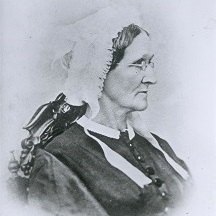
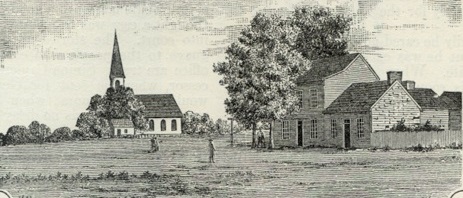
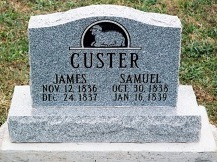
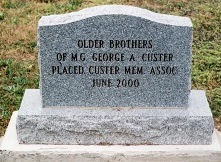
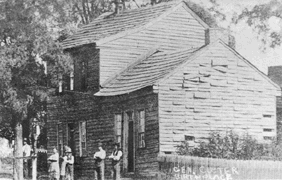
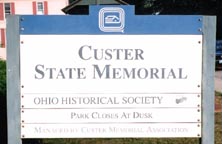
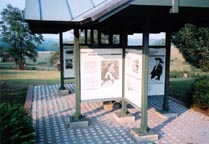
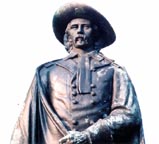
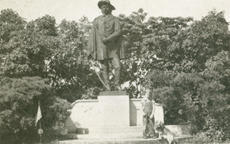
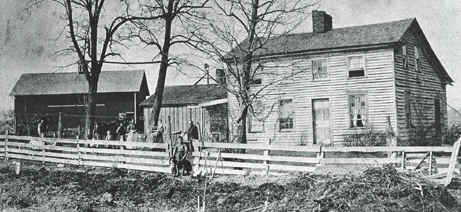
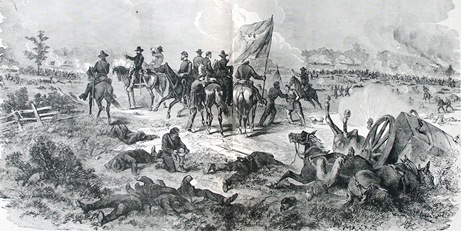
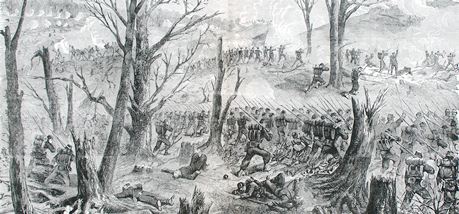
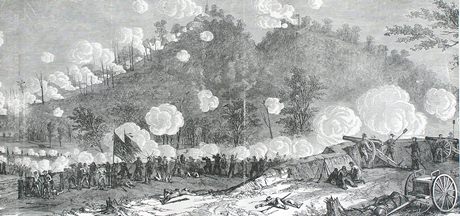
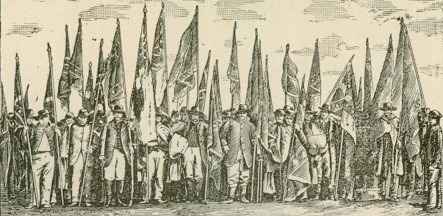
 Thomas
Ward Custer remained in the service of the United States Army after the
end of the Civil War. He joined the staff of his brother George in the
7th Cavalry regiment. Their first assignment was to occupy postwar Texas
in May 1865. Two years later, they were on the Great Plains, ordered to
protect builders of the Kansas Pacific, Union Pacific and Central
Pacific Railroads. In 1873, their mission to was protect the construction of the Northern Pacific Railroad as well as gold
mining operations in the Black Hills of South Dakota, a territory which
Native Americans considered sacred hunting ground.
Thomas
Ward Custer remained in the service of the United States Army after the
end of the Civil War. He joined the staff of his brother George in the
7th Cavalry regiment. Their first assignment was to occupy postwar Texas
in May 1865. Two years later, they were on the Great Plains, ordered to
protect builders of the Kansas Pacific, Union Pacific and Central
Pacific Railroads. In 1873, their mission to was protect the construction of the Northern Pacific Railroad as well as gold
mining operations in the Black Hills of South Dakota, a territory which
Native Americans considered sacred hunting ground.
